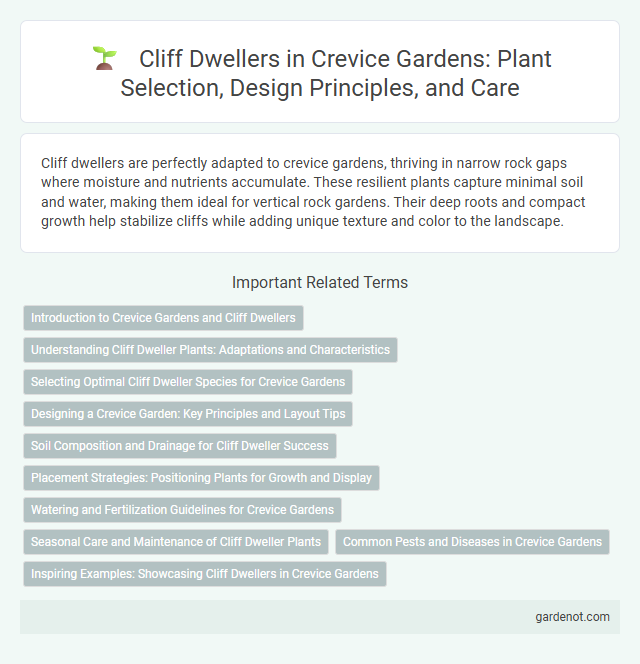Cliff dwellers are perfectly adapted to crevice gardens, thriving in narrow rock gaps where moisture and nutrients accumulate. These resilient plants capture minimal soil and water, making them ideal for vertical rock gardens. Their deep roots and compact growth help stabilize cliffs while adding unique texture and color to the landscape.
Introduction to Crevice Gardens and Cliff Dwellers
Crevice gardens mimic natural rock fissures, providing ideal habitats for cliff dwellers--plants adapted to survive in narrow, rocky environments with minimal soil. These specialized gardens offer excellent drainage and thermal insulation, crucial for the growth of alpine and desert species that thrive in harsh conditions. By recreating the microhabitats of cliff dwellers, crevice gardens support biodiversity and enable the cultivation of unique flora rarely found in traditional gardens.
Understanding Cliff Dweller Plants: Adaptations and Characteristics
Cliff dweller plants exhibit specialized adaptations such as deep-root systems and drought-resistant foliage to thrive in narrow rock crevices with minimal soil and water. Their ability to anchor firmly into fissures and withstand extreme temperature fluctuations enables survival in harsh cliff environments. Unique characteristics include compact growth forms and efficient nutrient absorption mechanisms critical for sustaining life in these challenging habitats.
Selecting Optimal Cliff Dweller Species for Crevice Gardens
Choosing optimal cliff dweller species for crevice gardens involves selecting plants that naturally thrive in rocky, well-drained environments with minimal soil. Succulents such as Sempervivum and Sedum, alongside drought-tolerant alpine species like Saxifraga, adapt well to the narrow fissures and temperature fluctuations characteristic of crevice gardens. Prioritizing species with deep root systems and resilience to wind exposure ensures long-term survival and aesthetic appeal.
Designing a Crevice Garden: Key Principles and Layout Tips
Cliff dwellers thrive in crevice gardens that mimic their natural rocky habitats, emphasizing well-drained soil and narrow rock fissures for root anchorage. Designing a crevice garden requires arranging stones vertically to create deep pockets that retain moisture while promoting air circulation, essential for drought-resistant plants like sedums and saxifrages. Strategic layering of rocks combined with a diverse selection of alpine species ensures year-round visual interest and ecological balance in the garden layout.
Soil Composition and Drainage for Cliff Dweller Success
Cliff dweller plants thrive in soil compositions that mimic rocky, well-drained environments, often characterized by sandy or gravelly substrates with low organic matter. Effective drainage is crucial, as these plants are adapted to prevent root rot by allowing water to quickly percolate through crevices and avoid waterlogging. Incorporating coarse materials such as expanded shale or crushed granite enhances soil aeration and supports the natural drainage conditions essential for cliff dweller success.
Placement Strategies: Positioning Plants for Growth and Display
Cliff dwellers thrive in crevice gardens by benefiting from strategic placement in narrow, shaded fissures that mimic their natural alpine habitats. Positioning these plants in elevated or vertical crevices ensures optimal drainage and airflow, which prevents root rot and promotes robust growth. Selecting crevices with varied exposure to sunlight enhances display by showcasing contrasting foliage textures and flowering patterns throughout the seasons.
Watering and Fertilization Guidelines for Crevice Gardens
Cliff dwellers thrive in crevice gardens with minimal watering, as their natural habitat involves well-drained rocky environments where overwatering can lead to root rot. Fertilization should be sparse, using a diluted, balanced liquid fertilizer once during the growing season to mimic nutrient-poor conditions. Maintaining proper drainage and avoiding excessive nutrient buildup supports healthy growth and flowering in these specialized plants.
Seasonal Care and Maintenance of Cliff Dweller Plants
Cliff dweller plants thrive in well-drained crevice gardens, requiring seasonal care to mimic their natural rocky habitats. During spring and fall, pruning dead foliage and removing invasive weeds help maintain healthy growth and prevent competition for nutrients. In winter, protecting these plants from excessive moisture and frost ensures their resilience, while summer demands moderate watering to avoid root rot.
Common Pests and Diseases in Crevice Gardens
Cliff dwelling plants in crevice gardens commonly face pests such as aphids, spider mites, and scale insects that thrive in dry, rocky environments. Fungal diseases like powdery mildew and root rot often occur due to poor drainage and excessive moisture retention within the crevices. Effective pest management includes regular inspection, maintaining good airflow, and using natural insecticides to preserve the delicate balance of the crevice garden ecosystem.
Inspiring Examples: Showcasing Cliff Dwellers in Crevice Gardens
Cliff dwellers, such as the Ancestral Puebloans of the American Southwest, exemplify how crevice gardens can create sustainable living spaces by integrating natural rock formations and vegetation. Their architectural innovations, utilizing narrow rock fissures for shelter and cultivation, demonstrate efficient use of limited resources in harsh environments. These inspiring examples highlight the potential of crevice gardens to support biodiversity and cultural heritage in arid landscapes.
Cliff dweller Infographic

 gardenot.com
gardenot.com